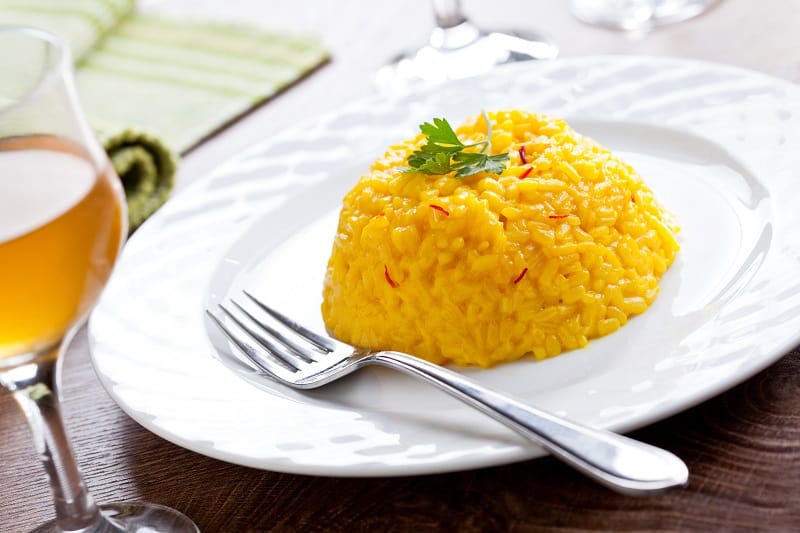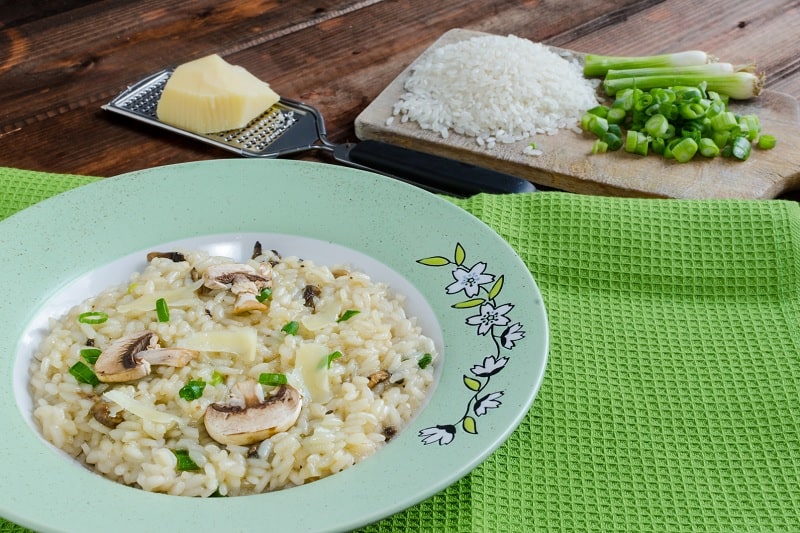Yes, you can use pudding rice for risotto, and other types of rice, too.
However, not using risotto-specific rice types in your dish, such as arborio rice, will affect how it tastes, the texture and consistency, and more.
Let’s take a look at what types of rice you should use, the types you shouldn’t use, and why it really matters…
How Much Does the Type of Rice Used Matter When Making a Risotto?
The type of rice you use in your risotto dish will actually make a big difference to not just the texture of the food, but also the flavour, appearance, and more.
It all comes down to starch.
What makes risotto slightly different from other rice-based dishes is that the starch within the grain is slowly and gradually forced out and into the liquid, usually stock or broth, that the rice cooks in.
This starch gives risotto dishes the creamy texture and flavour the dish is renowned for.
A higher starch content is better for a creamier, high-quality risotto. Because of this, white rice will make a creamier, high-flavoured risotto than brown rice, because white rice contains a higher starch content.
You will also want to avoid washing or rinsing the rice at any point during the cooking process. This will wash away some of the starch content.
Risotto is a dish that requires constant stirring during the cooking process, too. Because of this, the type of rice grain you use will have a big impact on the final result.
Longer, thinner grains can crumble under the weight of the constant stirring, giving you more less of the creaminess and more of the sloppiness.
The best type of rice to make a risotto is one that is relatively short (in the short to medium range), has a higher starch content (sometimes labelled as amylopectin), and has fatter grains.

What Type of Rice Is Typically Used to Make Risotto?
There are actually a number of different types of rice you can use to create risotto, especially when you look closer at the full range of proper Italian rice types. There isn’t just one specific type that you should use.
Generally, it all comes down to what type the recipe calls for, but different chefs will have their own favourite type of rice when it comes to making this creamy dish. After a few attempts of making risotto, you will likely find your specific favourite type of rice, too.
As well as various grain thicknesses, such as superfino, fino, semifino, and commune, you’ll also find different types when you get into the different size types. In superfino rice types, for example, you will find Vialone Nano, Carnaroli, and Arborio rice.
The most common type of rice used to make risotto, particularly in the UK, is arborio rice. This is medium grain rice, and it helps to create a bolder, stronger flavour than other types.
The grains will soak up lots of fluid, resulting in a risotto that is full-flavoured and creamy. You can easily overcook arborio rice, however.
Canaroli is another popular type for risotto, once again from the superfino group. The rice grains do not collapse or crumble with the constant stirring, and it is also relatively easy to work with, particularly for risotto beginners.
If you were to head to Northern Italy, however—Veneto to be exact—you would find that the most common type of rice used to make a risotto is the Vialone Nano type.
This rice also soaks up a lot of fluid easily and quickly, resulting in full-flavoured risotto dishes. Vialone Nano is usually used in waterier, soup-like risottos, and it is faster to cook than other types.
Other types of rice you could consider using to make a risotto include:
- Baldo rice, which is similar to Arborio – plump grains, and a medium grain length;
- Sushi rice, which has a high starch content, is low in calories, and has a short grain length;
- Bomba rice, which is a short-grain type of rice that comes from Spain, and is sometimes referred to as Valencia rice.
If you are looking for a non-rice substitute, you could look at pearled barley. This has a high starch content and still retains its shape somewhat during the cooking process.

Kim is a writer with more than a decade of experience, and a food enthusiast. When she’s not spending her time writing about her favourite dishes, you can find her in the cake aisle of her local supermarket, or making a mess in the kitchen.

